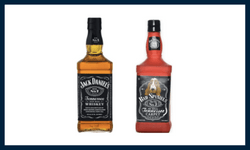The U.S. Supreme Court has rendered only 15 trademark opinions since 1924. So, it is always noteworthy when the Court considers a trademark case. This term, as we anticipated, the Court rendered its decision in the Jack Daniel’s trademark infringement case. We’ve been following this case since 2020 so you may recall the facts but here’s a refresher:
VIP Products (“VIP”) sells, among other things, a line of toys consisting of vinyl replicas of liquor, beer, wine, and soda brands labeled with humorous names, usually related to dog poop. In 2013, VIP released a bottle in the likeness of Jack Daniel’s, calling it “Bad Spaniels,” “43% POO BY VOL” and “100% SMELLY.” In short, Jack Daniel’s didn’t think this was funny and sued VIP for trademark infringement and tarnishment (i.e., harm to its reputation).
The case history is somewhat convoluted but central to the Court’s decision was application or not of a case called Rogers vs. Grimaldi, which was decided by the U.S. Court of Appeals for the Second Circuit in 1989. That court developed a test — referred to as, yes, the “Rogers test” — which was designed to protect “expressive works” from trademark infringement claims. The test basically stated that the trademark user is protected by the First Amendment unless the aggrieved party (i.e., the party whose mark was infringed) can demonstrate (1) that the challenged use of the mark “has no artistic relevance to the underlying work” or (2) that it “explicitly misleads as to the source of the content of the work.” In the Jack Daniel’s case, the District Court said that the Rogers test doesn’t apply if VIP was using its Bad Spaniels mark as a trademark. The court found that it was and granted judgment in favor of Jack Daniel’s. The Court of Appeals disagreed, awarding judgment on the dilution claim to Jack Daniel’s and sending the case back to see if Jack Daniel’s could prove either element of the Rogers test. This time the District Court granted summary judgment in favor of VIP because Jack Daniel’s could not prove the elements of the Rogers test but left the tarnishment verdict in Jack Daniel’s favor intact. Jack Daniel’s successfully appealed to the United States Supreme Court, and this month the Court rendered its opinion.
The U.S. Supreme Court agreed with the District Court’s original opinion, writing that the Roger’s test, even though it was designed to protect First Amendment rights, was developed to apply to a different kind of case, not where the defendant was using its infringing trademark as a source identifier. In that situation, standard trademark principles apply, meaning that if the plaintiff can prove that the trademark created confusion in the marketplace, liability would be imposed. In the Court’s words:
Today, we choose a narrower path. Without deciding whether Rogers has merit in other contexts, we hold that it does not when an alleged infringer uses a trademark in the way the Lanham Act most cares about: as a designation of source for the infringer’s own goods.
The Rogers test only applies to trademarks that perform some other expressive function, not as a source identifier. In the Court’s view, if the Ninth Circuit’s approach were to prevail, “few cases would even get to the likelihood-of-confusion inquiry if all expressive content triggered the Rogers filter.” The Court concluded that its reasoning:
fits trademark law, and reflects its primary mission. From its definition of “trademark” onward, the Lanham Act views marks as source identifiers—as things that function to “indicate the source” of goods, and so to “distinguish” them from ones “manufactured or sold by others.” In such cases, Rogers has no proper application. Nor does that result change because the use of a mark has other expressive content. Under the Ninth Circuit’s approach, Bad Spaniels was automatically entitled to Rogers’ protection because it “communicate[d] a humorous message.”
In this context, VIP was hoist by its own petard. The Court wrote, “[VIP] thus represented in this very lawsuit that the mark and [trade] dress, although not registered, are used to” identify and distinguish its goods. In other words, it was using Jack Daniel’s trademark as a source identifier. With respect to Jack Daniel’s tarnishment claim, the Court opined, “no parody, criticism, or commentary will rescue the alleged dilutor. It will be subject to liability regardless.”
So, there you have it in a nutshell. We have seen in our own practice trademark applicants desiring to make fun of famous trademarks. Not an uncommon practice; however, in light of the Supreme Courts’ opinion, it’s a risky marketing strategy.
— Adam G. Garson, Esq.


